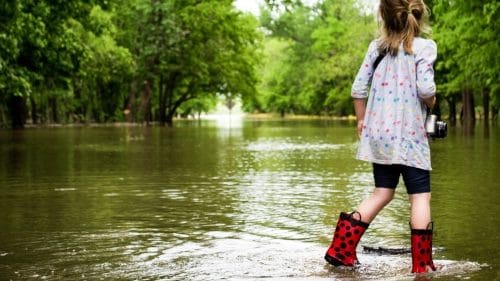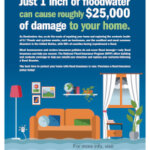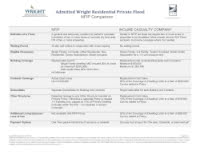Table of Contents[Hide][Show]
- Why Every Florida Homeowner Should Consider Flood Insurance
- Flood Risk Across Florida: Understanding Your Region
- Factors That Affect Florida Flood Insurance Rates
- Can Anything Help My Flood Rates? Any Flood Discounts?
- Debunking Common Myths About Florida Flood Insurance
Frequently Asked Questions About Florida Flood Insurance+−
- Do I need flood insurance in Florida if I’m not near the coast?
- What is the difference between NFIP and private flood insurance in Florida?
- How much does flood insurance cost in Florida?
- How long does it take for flood insurance to start in Florida?
- Can I get flood insurance if my Florida home has been flooded before?
- Does flood insurance cover my pool, deck, or detached garage in Florida?
- What Florida areas are considered high-risk for flooding?
- Will my homeowners insurance cover flood damage in Florida?
- How to Get Flood Insurance in Florida
- Florida Flood Resources
- The Peace of Mind That Florida Flood Insurance Provides
- Flood Insurance in Your Florida Community
Floods are a serious concern for Florida homeowners from Pensacola to Jacksonville, down through Tampa Bay, Orlando, and the Keys. With our long coastline, low-lying terrain, and frequent tropical systems, it’s no surprise that floods are among the most common and costly disasters affecting Florida homes. Unfortunately, most homeowners’ insurance policies do not cover flood damage. That’s why having a reliable Florida Flood Insurance plan is so important to protect your property and your savings from unexpected repairs.
Flooding in Florida doesn’t just come from a direct hurricane hit. Slow-moving thunderstorms, stalled tropical systems, king tides, overflowing rivers, and overworked drainage systems can all push water into streets, yards, and homes. We believe Florida families deserve clear, practical information about their real flood risk and how the right Florida Flood Insurance coverage can help.
Why Every Florida Homeowner Should Consider Flood Insurance
Flooding in Florida can happen in many ways. Coastal communities see storm surge and king-tide flooding, while inland neighborhoods deal with heavy rainfall, overflowing lakes and rivers, and water backing up from retention ponds and storm drains. From Jacksonville to Miami, and from Tampa Bay to the Keys, many areas that look “high and dry” most of the year can still flood during the wrong storm.
National data shows that a significant portion of flood insurance claims come from properties outside the officially mapped high-risk flood zones. In other words, being in a FEMA “X zone” or a moderate-risk area does not mean you are safe from flooding. Many Florida homes that have filed flood claims were never told they “had to” buy flood insurance, and a large share of Florida properties carry some level of flood risk even when that risk is not obvious from the map alone.
The cost of repairing flood damage can be devastating without the proper coverage in place. FEMA and NFIP have highlighted that even just one inch of water in a typical home can lead to tens of thousands of dollars in damage once drywall, flooring, cabinets, and electrical systems are affected. Because protecting your home and savings matters, you deserve a clear understanding of your Florida Flood Insurance options before the water rises, not after.
Flood Risk Across Florida: Understanding Your Region
Florida is one state, but flood risk looks very different from one region to another. Knowing how water tends to move where you live can help you make better decisions about Florida Flood Insurance for your home.
Gulf Coast (Tampa Bay through Naples)
Tampa Bay and nearby rivers like the Hillsborough, Alafia, and Little Manatee can push tidal and river water into low-lying neighborhoods during strong storms. From Clearwater and St. Pete down through Bradenton, Sarasota, Fort Myers, and Naples, coastal communities face storm surge and wind-driven waves, while inland suburbs deal with heavy rain and drainage issues during hurricanes and tropical systems.
Atlantic Coast (Jacksonville to Miami)
Around Jacksonville and the St. Johns River, and along the Intracoastal Waterway, river and back-bay flooding can occur when heavy rain stacks up with high tides. In South Florida, including Miami-Dade, Broward, and Palm Beach counties, king tides, sea-level rise, and aging drainage systems can create “sunny day” flooding on some streets even without a major storm.
Panhandle and Big Bend
The Florida Panhandle and Big Bend region have seen powerful landfalling hurricanes that bring strong storm surge and heavy rainfall. Barrier islands, coastal communities, and river towns can all be affected, and even homes that feel “inland” may sit along rivers or creeks that rise quickly when a Gulf storm stalls or moves slowly across the area.
Central Florida and the I-4 Corridor
In Central Florida, flooding is more about rainfall, lakes, and retention ponds than direct ocean surge. Communities around Orlando, Lakeland, and the I-4 corridor can see water build up around lakes, canals, and stormwater systems during slow-moving tropical storms and intense summertime thunderstorms, impacting neighborhoods that are miles away from the coast.
South Florida and the Keys
The Florida Keys and parts of South Florida sit only a few feet above sea level in many spots. Sea-level rise, repeated king-tide events, and limited places for water to drain create ongoing, chronic flood concerns. In these areas, understanding how often water covers roads or yards is just as important as understanding major hurricane risk.
No matter which part of Florida you call home, your real flood risk comes down to your specific address, elevation, distance to water, and construction details. Because every property is unique, we always recommend using the instant quote tools on this page or talking with our team to see Florida Flood Insurance options for your exact location.
Understanding Florida Flood Insurance Coverage
Flood insurance in Florida is available through two main sources. The National Flood Insurance Program (NFIP) provides standardized, government-backed policies, while private insurers offer more flexible, customized options. Both can be valuable, and the best fit depends on your home, your loan requirements, and your comfort level with coverage.
1. National Flood Insurance Program (NFIP)
The NFIP is the most common starting point for Florida Flood Insurance, especially for homes in areas where lenders require coverage. NFIP policies can protect both your building and your personal belongings, with standard maximum limits available on a typical residential policy.
- Up to $250,000 in coverage for the structure of your primary residence.
- Up to $100,000 in coverage for eligible personal property inside the home.
- Standard policy forms and rules that are widely recognized by mortgage companies.
NFIP coverage does have limits and exclusions. Certain items in basements, some outdoor property, and specific features of the home may not be covered. Most NFIP policies also include a 30-day waiting period before coverage begins, with a few exceptions such as certain loan closings. Because of these rules, it is important to review what is and is not included before a storm is on the radar.
2. Private Flood Insurance Options
Private flood insurance is an alternative that can provide more flexible and expanded options than a standard NFIP policy. Many private carriers in Florida use their own underwriting models and can offer higher limits and additional features for certain homes that qualify.
- Higher building limits than standard NFIP policies for many primary and secondary homes.
- More flexible options for contents coverage and, in some cases, additional living expenses if your home is uninhabitable after a flood.
- Potential coverage for pools, decks, and certain detached structures when included by the carrier.
- Waiting periods that can sometimes be shorter than NFIP’s standard 30 days, depending on carrier rules and storm activity.
In real life, private flood can sometimes be less expensive, similar, or more expensive than NFIP for the same address. It depends on how each program views your specific risk factors. Because Risk Rating 2.0 and private carrier models both use address-level data, two homes on the same street can see very different premiums. That is why using the quote widget on this page to run your exact Florida address is so important.
Excess Flood Insurance
Excess flood insurance is designed for higher-value homes where the NFIP’s building limit is not enough. In these cases, a homeowner may choose to keep an NFIP policy for the base layer of protection and then add an excess policy on top to better match the home’s rebuild cost. There are underwriting guidelines and availability considerations, but for the right properties, this layered approach can offer broader protection against catastrophic loss.
Factors That Affect Florida Flood Insurance Rates
With FEMA’s Risk Rating 2.0 and modern private flood models, Florida Flood Insurance pricing is more property-specific than ever. Instead of just looking at a broad zone on a map, today’s systems consider how water is likely to reach your exact home and how expensive it would be to repair.
Some of the key factors that can influence your Florida Flood Insurance rate include:
- Flood zone and type of flooding. Coastal surge, river flooding, and heavy rainfall all show up differently in the models.
- Distance to water. How close you are to the coast, a river, a canal, a lake, or even a neighborhood retention pond can affect risk.
- Elevation and first-floor height. Homes built higher above the surrounding grade, or elevated on piers or stem walls, may perform differently in a flood.
- Construction and foundation type. Slab, crawlspace, piling, and other foundations behave differently when water rises around them.
- Replacement cost and home characteristics. Larger or more expensive homes may require more coverage, which impacts premiums.
- Prior flood losses. A history of claims at the property can affect pricing and eligibility with both NFIP and private carriers.
- Coverage limits and deductibles. Higher limits and lower deductibles provide more protection but generally cost more than bare-minimum options.

Because so many details go into modern flood rating, statewide averages and sample premiums can be misleading. Two neighbors in the same subdivision can see different prices based on foundation height, distance to water, and other address-level factors. The simplest way to see what Florida Flood Insurance might look like for your home is to use the quote widget on this page or contact our team for a custom review.
Can Anything Help My Flood Rates? Any Flood Discounts?
Elevation Certificate
An elevation certificate can sometimes help clarify how your home actually sits compared to surrounding flood risk. Flood maps show broad zones, but they do not always capture the fact that one house might sit higher on a pad, on a small hill, or on an elevated foundation. An elevation certificate documents those details in a format that NFIP and some private carriers can use.
Elevation certificates answer questions like how high the lowest floor is above ground, how water would flow around the building, and what kind of openings or drainage features exist in crawlspaces or enclosures. Under Risk Rating 2.0, more of this data is being captured through other sources, but an accurate elevation certificate can still be valuable in some situations, especially for older properties in higher-risk areas.
In Florida, elevation certificates may already be on file with your city or county, particularly for newer construction or homes that were built or substantially improved after local floodplain rules were updated. If you need a new one, a licensed surveyor can usually provide it. Floods.org shares additional tips on how these certificates work and when they might help.
Prior NFIP Flood Insurance
For buyers purchasing a Florida home, knowing whether the seller had an NFIP flood policy in place can be very important. When prior NFIP policy information is available, it may allow FEMA’s system to recognize long-term coverage history, earlier elevation data, or other factors that are not obvious from the map alone. In our experience, we have seen situations where having those prior details made a meaningful difference in the new owner’s premium compared to starting from scratch.
This can happen for several reasons. Older NFIP policies were often written using elevation certificates, and that data may still help show that a home is built higher than the general area suggests. In addition, under Risk Rating 2.0, there can be aspects of continuity and rating history that benefit properties with long-standing NFIP participation. While no specific savings are guaranteed, it is always worth asking the seller, their agent, or the closing team whether there is an existing NFIP policy and whether those details can be shared for quoting.
Debunking Common Myths About Florida Flood Insurance
There are several misconceptions about Florida Flood Insurance that hold people back from getting coverage they may someday wish they had. Let’s clear up some of the most common myths we hear from homeowners around the state.
- “My homeowners insurance covers flooding.”
Most standard homeowners policies in Florida do not cover damage from rising water outside the home. Water that enters because of storm surge, overflowing rivers, heavy rainfall runoff, or backing up from overwhelmed drainage systems is generally considered a flood, and it requires a separate flood insurance policy in most situations. - “I’m not in a flood zone, so I don’t need insurance.”
Every property is in some type of flood zone. Being in a non-mandatory or “X zone” area simply means your lender may not require flood insurance. National NFIP data shows that a significant portion of flood claims come from outside the highest-risk zones. Nearly every county in the United States has seen flooding at some point, and Florida is no exception.- After Hurricane Ian, a friend shared that they had lived in Florida for decades, never been told they “needed” flood insurance, and did not live in a mapped high-risk zone. A retention pond behind their home overflowed, several inches of water entered the house, and they quickly saw how fast drywall, cabinets, and flooring can be ruined. Looking back, they wished they had carried a flood policy before that storm.
- After Hurricane Debby, many homes in Bradenton and Sarasota experienced flooding in neighborhoods considered lower risk on traditional flood maps. We never share those stories to scare anyone or celebrate loss, but to help Florida homeowners understand that “low risk” does not mean “no risk,” especially in a state with such complex water and drainage patterns.
- “Florida flood insurance is always too expensive.”
Flood insurance pricing in Florida depends on your specific address, elevation, construction, distance to water, and coverage choices. Some homes see higher premiums, while others qualify for more moderate options. Instead of guessing from averages or national headlines, we encourage homeowners to use the instant quote tools on this page or call our agency so we can show real NFIP and private options for their exact property.
Frequently Asked Questions About Florida Flood Insurance
Do I need flood insurance in Florida if I’m not near the coast?
Yes. Flooding in Florida happens inland as well as on the coast. Communities around Orlando, Lakeland, the I-4 corridor, and other inland areas experience flooding from heavy rainfall, overflowing retention ponds, rivers like the Alafia and Hillsborough, and overwhelmed drainage systems. National NFIP data shows that a significant portion of flood insurance claims come from outside high-risk coastal zones. Even properties in FEMA’s moderate- or low-risk “X zones” can flood during slow-moving storms, making flood insurance a smart protection regardless of your distance from the beach.
What is the difference between NFIP and private flood insurance in Florida?
NFIP (National Flood Insurance Program) provides federally backed, standardized coverage with limits up to $250,000 for your home’s structure and $100,000 for personal property. NFIP policies follow consistent rules and are accepted by all mortgage lenders. Private flood insurance is offered by commercial insurance companies and can provide higher coverage limits, optional replacement cost coverage, additional living expenses if your home is uninhabitable, and sometimes shorter waiting periods (7-10 days vs NFIP’s typical 30 days). Pricing varies by property—some Florida homes see better rates with NFIP, while others qualify for more competitive private flood pricing. The best approach is to compare both options for your specific address.
How much does flood insurance cost in Florida?
Florida flood insurance costs vary widely based on your property’s exact location, elevation, distance to water, flood zone, construction type, age of the home, and the coverage limits you choose. With FEMA’s Risk Rating 2.0 and modern private flood models, premiums are calculated using property-specific data rather than broad zone averages. Two homes on the same street can see different rates. Some Florida properties in low-risk areas may see annual premiums starting around $400-$700, while properties in high-risk coastal or riverfront zones may see higher costs. The only accurate way to know your cost is to get a quote based on your specific Florida address. You can use the widget on this page to get a quick, easy estimate for your home.
How long does it take for flood insurance to start in Florida?
NFIP flood insurance policies typically require a 30-day waiting period before coverage begins, though exceptions exist for certain loan closings and specific circumstances. Private flood insurance policies may offer shorter waiting periods, sometimes as little as 7-10 days depending on the carrier and current storm activity. Because of these waiting periods, Florida homeowners should purchase flood insurance well before hurricane season (June 1 – November 30) rather than waiting until a storm is approaching. Once a tropical system is named or a flood watch is issued, it may be too late to obtain new coverage before the storm arrives.
Can I get flood insurance if my Florida home has been flooded before?
Yes, you can still obtain flood insurance even if your Florida property has a history of flood claims. Both NFIP and private flood carriers will still provide coverage, though prior losses may affect your premium and, in some cases, your coverage options. Properties with repetitive flood loss history may see higher rates or may need to meet certain mitigation requirements. However, coverage is typically still available. If you’ve experienced previous flooding, contact Think Safe Insurance at 813-425-1626 to review your specific situation and identify the best available NFIP or private flood options for your property.
Does flood insurance cover my pool, deck, or detached garage in Florida?
NFIP flood insurance has limited coverage for detached structures like garages (up to $10,000 and only for certain uses) and typically does not cover pools, decks, patios, fences, or landscaping. Private flood insurance policies may offer broader coverage options for these features, depending on the carrier and policy terms. If protecting your pool, deck, screened enclosure, or detached structures is important to you, ask about private flood options when getting quotes. Many Florida homes have these features, so understanding what is and isn’t covered can help you avoid surprises after a flood event.
What Florida areas are considered high-risk for flooding?
High-risk flood areas in Florida include coastal communities along the Gulf Coast (from Pensacola to Naples) and Atlantic Coast (from Jacksonville to Miami and the Keys), properties near rivers like the St. Johns, Hillsborough, Alafia, and Little Manatee, barrier islands throughout the state, and low-lying neighborhoods in flood zones designated by FEMA as Special Flood Hazard Areas (SFHAs). However, flood risk exists throughout Florida, even in moderate- and low-risk zones. Inland areas around Orlando, Lakeland, and the I-4 corridor experience flooding from heavy rainfall and retention pond overflow. Recent hurricanes like Ian, Idalia, and Debby have shown that flooding can occur far beyond traditionally mapped high-risk zones, which is why flood insurance is recommended for all Florida homeowners regardless of their designated flood zone.
Will my homeowners insurance cover flood damage in Florida?
No. Standard Florida homeowners insurance policies do not cover flood damage. Flooding caused by storm surge, heavy rainfall, overflowing rivers or retention ponds, or water backing up from drainage systems requires a separate flood insurance policy from either the NFIP or a private flood insurance carrier. Homeowners insurance typically covers wind and rain damage to your roof or interior from a storm, but it specifically excludes rising water from outside the home. This is one of the most common misconceptions among Florida homeowners and has led to many families facing unexpected out-of-pocket costs after hurricanes and tropical storms. To protect your home from flood damage, you must purchase a separate Florida flood insurance policy.
How to Get Flood Insurance in Florida

Getting flood insurance in Florida does not have to be complicated. On this page, you can use our instant quote tools to enter your Florida property address and see NFIP and private flood options based on your specific location. Because these systems use address-level data, the results will be far more accurate than any statewide “average.”
If you prefer to talk it through, our team at Think Safe Insurance is here to help. Call us at 813-425-1626 or request a quote online, and we will review NFIP and private flood options side-by-side. As a Florida-based independent agency, we believe you deserve real choices, not one-size-fits-all answers for your Florida Flood Insurance.
If you already have an elevation certificate, or if you are buying a home and the seller can provide a copy of their existing NFIP flood policy, share that information when you contact us. It is not required, but it can give us more complete data for the quote and may improve how certain carriers view the property.
Florida Flood Resources
Stay prepared and informed—these trusted resources can help you better understand and manage flood risk in your Florida community.
- Florida Division of Emergency Management: Statewide emergency updates, preparedness tips, and local flood maps.
- FEMA Region 4 (Southeast): Florida-specific flood programs, disaster assistance, and official flood maps.
- Florida Floodplain Managers Association: Technical guidance and best practices for Florida property owners, builders, and HOAs.
- County Emergency Management Offices: Find your local county’s flood alerts, evacuation routes, and sandbag locations.
Still have questions about protecting your property? Contact our team for personalized Florida flood insurance guidance.
The Peace of Mind That Florida Flood Insurance Provides
Flooding is unpredictable, but your plan for it does not have to be. From coastal towns to inland suburbs, Florida residents face unique water and weather challenges that can change quickly from season to season. A well-designed Florida Flood Insurance policy helps protect your home, your belongings, and your long-term financial stability when the unexpected happens.
Get started today by using the quote tools on this page or contacting Think Safe Insurance for a personalized review. We will explain your NFIP and private options in plain language, walk you through the pros and cons, and help you choose coverage that fits your home, your budget, and your comfort level. You deserve guidance you can trust from a Florida-based team that understands how flood risk really works in our state.
Flood Insurance in Your Florida Community
Looking for Florida Flood Insurance information tailored to your neighborhood? Explore our local Florida flood guides to learn more about coverage and risks in your area.
If you do not see your community listed, we can still help with Florida Flood Insurance anywhere in the state. Call 813-425-1626 or use the quote tools on this page to see options for your exact address.



